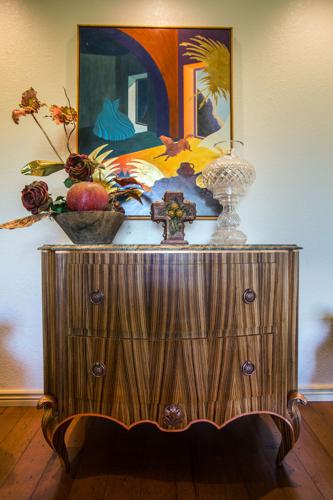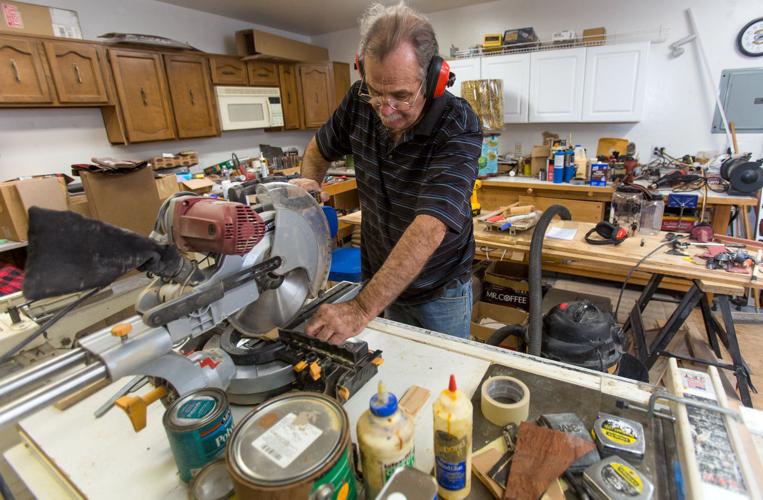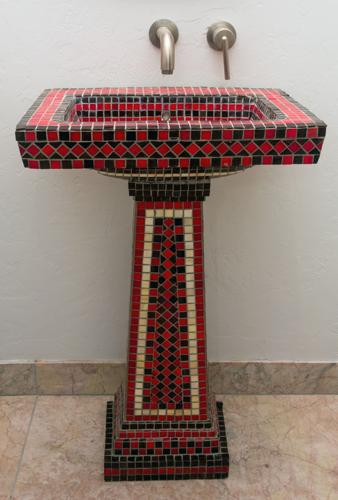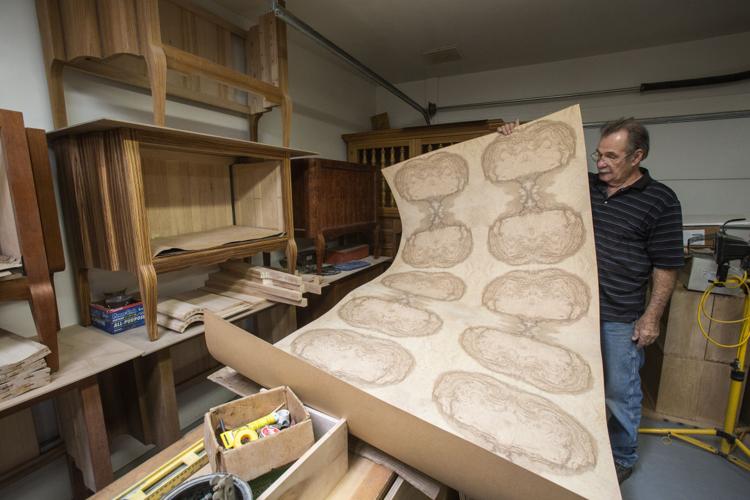Howard Curtin is one of those unique individuals who blurs the lines of art and construction with his craft.
Is he an artist? His work would suggest he is.
Is he a homebuilder? Well, yes, albeit retired.
Is he an architect? Ditto.
Is he a furniture builder? That, too.
Add it all up and you have a range of work that has been seen around Tucson for more than 40 years, although most locals might not know it.
For the last eight years, Curtin has been a retired homebuilder who crafts his furniture in a shop at the Foothills-area home he built for himself and his wife, Georgia, tucked into the hills not far from the Tucson Jewish Community Center.
Before he started focusing on furniture in 2007, Curtin said he designed and built exactly 100 mostly high-end, custom homes through work he obtained generally by word of mouth. In his free time, he also oil paints, sometimes coming up with his own designs, other times adapting photos and other paintings he sees into a piece of art.
Even in the pieces of furniture Curtin chooses to build in his so-called retirement, there is a blurring of just how they are defined.
Now 76 years old, Curtin builds commodes, which, by the Merriam-Webster definition, is “a low piece of furniture with drawers or sometimes a door and shelves.” It’s the definition Curtin prefers over another common definition: “a chair with a hole in the seat and a pot underneath that is used as a toilet.”
Curtin’s commodes stand on four legs, are about three feet high, about four feet wide and about two feet deep. They have two drawers or cabinets, depending on the design. The marble or granite top is not permanently connected to the piece giving the owner the option to lift it off to put items inside. Curtin does have a design mechanism to help the owner center the top on the cabinet when putting it back.
And then there are the Curtin trademarks — at least two secret compartments you most likely will not find without being told where they are, and at least four hidden signatures burned into the wood throughout the piece.
“These compartments are very hard to find,” Curtin says on his website. “Documents, jewelry and special mementos are examples of what one might secure in the secret compartments.”
Other than suggesting what might go in the secret compartments, Curtin said he has no idea just what owners might put in the cabinets and drawers.
“What it is is a piece to go in your foyer with a mirror above it,” he said. “I wanted to build something that wasn’t rectangular, so I came up with building them smaller in the front and bigger in the back with a design all around them.”
One of the owners of a piece, local nurse Richard Dooley, got one as a gift from Curtin a few months ago, and he’s one of those who hasn’t figured out just how to use it, although he says he’s “in awe” of its beauty.
Dooley and Curtin met through their wives who worked together at a local beauty salon. On Dooley’s first visit to Curtin’s home, he got a sense of Curtin’s artistic talent, not only in the furniture he was building, but in his oil paintings that dot the home, and through photos of the homes Curtin designed and built in the Tucson area.
“He had just built this amazing home on Hacienda del Sol,” Dooley said. “It was just a stunning house with views of the Catalinas. Then I saw his furniture. I was just in awe. The level of craftsmanship is stunning.”
Dooley said his piece sits prominently against a wall in a space between his living room and kitchen where he might use it to serve wine.
“My wife and I have a small house, and that’s about the only place we can put it in our house,” Dooley said. “It works for us there. Right now the drawers are empty. We haven’t figured out what to put in it.”
The furniture building all started for Curtin as a youngster growing up in Illinois in the 1950s. The high school he attended for a time in Aurora was run by Benedictine monks, one of whom was a cabinet maker who taught Curtin the beginnings of what would become a lifelong craft. Later, as he considered actually becoming a monk himself, Curtin said, he went to the Saint Meinrad Seminary & School of Theology for his junior year of high school where he would go to school in the morning and then work in the cabinet shop in the afternoon.
Eventually, Curtin said, he decided to head in a different direction professionally, and before he knew it, he had moved back to Illinois and opened a home remodeling business. That ultimately led to him becoming a registered contractor when he moved to Arizona in 1969, and he started working on the 100 homes.
“When I moved to town in 1969, within a couple of weeks I went down to the building department and took the test” for registered contractors, Curtin recalled. “I walked out of the building and I said, ‘I think I’ll build 100 homes and quit.’ I remember saying that to myself.
“When I got to the 100, it was just before the (real-estate) crash, two or three months before all hell broke loose in 2007,” Curtin said. “And I said to myself, ‘Am I going to do what I said or not do what I said.’ And I said I’m gonna do it.”
By that time, Curtin had already started building furniture as a hobby. The first three commodes he built were of the same design. He gave away two to close friends and kept the third, which sits in a hallway at his home.
“I built those three pieces probably 10 years before I quit (building homes),” Curtin said. “I just wanted to get back to doing something that I learned in high school.”
And now he’s put the same limit on his furniture building business that he did on his homebuilding.
“I said I ought to build 100 (furniture pieces) to commemorate the 100 homes I did,” Curtin said, adding that all 100 pieces have been designed and are catalogued in a binder he keeps in his home office. “Whenever I’d go to Hawaii, I’d bring my pad, and I designed all the commodes over there. Whenever we weren’t doing anything I would design three or four at a time.”
As of today, Curtin has built 28 of the 100, selling some and giving a few away to close friends and family. He said he’s picked out the next 22 to get him halfway to the total he intends to build. A dozen are at various stages of construction in his shop.
“I’ll get those other 22 done in a couple of years,” he said.
One of those, a piece he calls “Wings,” he intends to finish within the next year and give it as a gift to the next president of the United States — “whoever that might be.”
“I went to the Ronald Reagan Library, and they’ve got everything everyone ever sent to him and they put it in storage and bring it out every once in a while,” Curtin said. “I hope whoever becomes the next president lets us fly again, lets us soar again.”
Curtin provides a laundry list of items and characteristics that go to the buyer of any of the commodes, including a name for each piece. Two of the pieces he has in his home are the “Copper Cobra” and his first piece, which he calls “A Warm Feeling.” Some other names of designed and not-yet-built pieces are “The Bear and the Wolf,” “Radius Beauty” and “Curves.”
But the one other thing that Curtin provides with his furniture is a bit of love.
“It’s a wonderful, wonderful thing to be able to do,” Curtin said. “I’m blessed that I can do that when I’m retired. I just love building those things.”
















